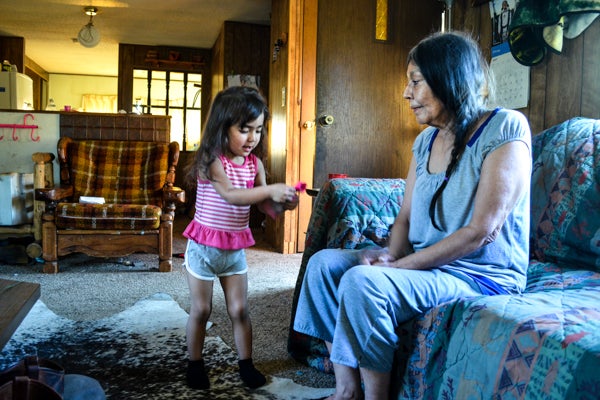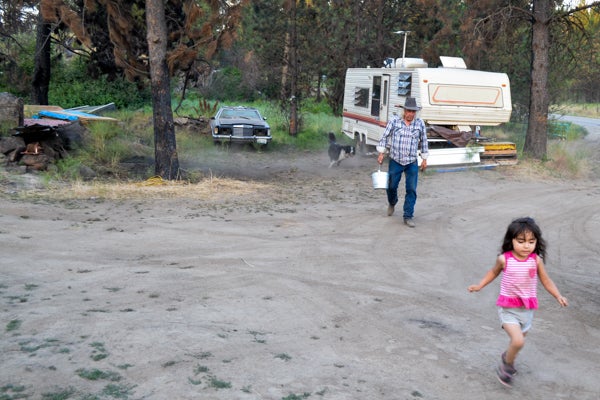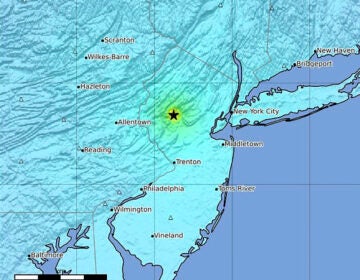Washington’s wildfire whipped up dangerous ‘weather’
Listen 6:53
The Spokane Reservation in eastern Washington was hit by a wildfire last year. (Eilis O'Neill/for WHYY)
Wildfires can create atmosphere changes around them — making raging infernos even more unpredictable and dangerous.
Western Washington — where Seattle is — is known for rain, but in the east, near Spokane, it’s a desert. The air smells of dust and pine trees, and, when you walk across bare ground, each step sets off little clouds. The drainage ditches are dry and cracked.
As hot, dry weather fuels increased wildfires in the western United States, researchers are finding that those fires can change the ‘weather’ around them.
Those meteorological changes — horizontal winds, water vapor, and updrafts — make it tricky to know where fires are going next.
Last summer when a wildfire first broke out on the Spokane Reservation where Danny and Noreen Wynne live, they weren’t worried. They spent the early part of the evening watching flames on the unpopulated side of the reservation, confident that the fire couldn’t cross the river to where they live. The river had always protected them before.
But, that Sunday, the fire jumped the Spokane River.
“Somebody came up and said we had to get out of here,” Noreen Wynne remembers, “so I ran into the house and grabbed my great-grandchild and ran out to the pickup, jumped in the pickup.”
The Wynne’s great-granddaughter, Dancer, lives with them.

Noreen and Dancer, who’s a toddler, left, but Danny stayed.
“And I was standing out here with a shovel and a garden hose like, you know, Smokey the Bear,” Danny says. “Blaine Keeper, one of our fire fighters, he come right up the driveway and he looked at me. He said, ‘Danny, you ain’t going to stop nothing with that.’ So I thought, ‘Yeah, you’re right, it’s coming pretty hard.'”
So Danny let his horses out and took off to join Noreen and Dancer. They spent the night in their pickups a safe distance from the fire.
Fire researchers are working to better predict where wildfires are going to go next. They want to protect emergency workers and to know when it’s time to tell people to evacuate and leave home.
That can be really difficult.
Craig Clements is a meteorology assistant professor at San Jose State University. He says the trickiest part of predicting where fires are headed is that wildfires can actually make their own weather. Well, some people call it weather. Other researchers call it fire-atmosphere interactions. Whatever you call it, here’s how it works.
Fires change wind direction through fire plumes: the hot air shooting up from a fire. That hot air “can create like a low pressure around the fire front — and, in response to that, what we call fire-induced winds can blow in from different directions,” Clements says.
Craig Clements and his colleagues now have fire-resistant equipment that they attach to planes that fly through fire plumes, so now they can get information about where air is moving, and how fast it’s going. They’re hoping that plugging data into computer models will help improve those models for predicting future fires.
Raging wildfires can also generate enormous amounts of smoke that drift downwind.
“Because the smoke is so dense, it blocks the sunlight and so when that happens, you can actually get cooler air forming at the surface, and that cooler air wants to flow in different directions than otherwise would be on a sunny day,” Clements says.
That’s another kind mini-weather system caused by fire.
Wildfires can also create clouds.
Burning plants release water vapor, and, at the same time, fire plumes can pull vapor from the air. All that can condense into clouds, which can rain. Other times, the clouds can start to rotate, creating spinning winds that carry burning branches or even whole trees far from the fire, even across a river.
Last year, on the Spokane Reservation, the spot where the fire leapt the river isn’t too much wider than a two-lane street — but that’s still a lot of water for a fire to cross. No one’s sure exactly how that happened, but it may have had to do with fire-induced wind.
“The wind kept changing, you know, shifting back and forth, and the fire goes with the wind,” Danny Wynne says.
The morning after the fire, Danny and Noreen went back to their land to look for their horses and take inventory. The horses were there waiting for them, but that was about all that was left.
“We lost everything but the clothes we had on and our two pickups,” Noreen says. “We lost three cars, a tractor, our house. I just had new curtains put in my living room and just everything burnt to a crisp.”

When I asked Noreen what she was most sad about losing, she started to cry.
“My pictures,” she said. “I don’t even like to talk about it. I’m the oldest daughter, and I got all the Indian pictures of my great-grandparents and stuff. They all burned up.”
Danny and two-and-a-half-year-old Dancer took me to see where their house used to be. Danny says the Spokane Tribe is supposed to start laying a foundation on their new home soon.
“You spend your life building a home,” he says. “Fire just slows you down, just makes more work for you. You’ve got to keep building. That’s the way I look at it.”
In the meantime, Noreen’s busy rebuilding her family photo collection: getting copies from her daughter, and taking new pictures. This time, she’s keeping them in a big, heart-shaped chocolate tin.
WHYY is your source for fact-based, in-depth journalism and information. As a nonprofit organization, we rely on financial support from readers like you. Please give today.






